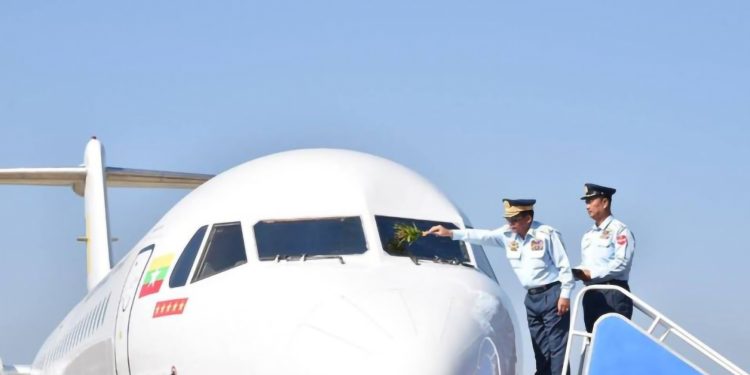Junta boss Min Aung Hlaing has two airliners parked in Naypyitaw for his exclusive use, a former Air Force officer has revealed.
Even his wife, Kyu Kyu Hla, reportedly can’t board the aircraft without him.
“[Min Aung Hlaing] has ordered that the planes cannot take off unless he is on board,” the ex-officer told The Irrawaddy.
The two planes are Fokker 70s, a Dutch-made twin-engine airliner with a capacity of 70 to 80 passengers. The pair are formally designated as Air Force VIP planes and kept at the Naypyitaw air base.
Min Aung Hlaing uses the Fokkers for both domestic and foreign trips. For trips to destinations without an airfield, he switches to an MI-17 helicopter.
Former military dictator Than Shwe was the country’s first leader to harbor dreams of a US-style “Air Force One”. But the presidential airplane was for his protégé, General Thein Sein, who he handpicked to helm the country in 2010 for the planned transition to democratic rule.
Than Shwe purchased an Antonov An-148 passenger jet from Russia the same year, and it was due to be handed over to Myanmar in 2011. However, the plane broke up in midair and crashed during a demonstration in central Russia on March 5, 2011, killing all six crewmembers.
The crash shattered the Air Force One dream of both generals.
Undeterred, Min Aung Hlaing purchased the two Fokker 70s after being appointed chief of the military. But since he was not officially the country’s president, he could only name his planes “Air Force 002” and “Air Force 003.”
According to protocol, Min Aung Hlaing ranked eighth in the government hierarchy when the Fokkers arrived – well behind the president, Htin Kyaw, and two vice-presidents, Henry Van Thio and Myint Swe.
In naming the two planes 002 and 003, he demonstrated his blatant disregard for protocol.
According to Myanmar Air Force defectors, the first Fokker was purchased for Min Aung Hlaing by his son, Aung Pyae Sone, through one of his companies, The plane arrived in Myanmar in April 2017. The Air Force chief at the time was General Khin Aung Myint.
The New York Times revealed that the two planes were purchased by junta crony Jonathan Kyaw Thaung, who has close ties with Khin Aung Myint.
In 2017, the Kyaw Thung family’s aviation company, MWG, negotiated to buy the two Fokkers from an arm of KLM Royal Dutch Airlines.
The purchase prompted questions in the Dutch parliament about how the Fokkers had ended up in the Myanmar Air Force fleet. The Dutch investigation concluded that the planes were purchased for commercial use by a Singaporean firm. That company was the Kyaw Thaung’s aviation arm, although it was not registered in Singapore at the time.
Myanmar’s Air Force normally procures aircraft, helicopters and weapon systems through companies owned by cronies who benefit from both buyers and sellers.
According to an official budget document seen by The Irrawaddy, the military has asked for an annual maintenance fund of US$ 510,000 for one of the Fokkers.
“The Fokkers were purchased through Italy. The engines were made by Rolls-Royce. The planes are not new, but they were in very good condition,” said a Myanmar Air Force defector.
The rest of the regime leadership, including deputy junta chief Soe Win, have no access to the Fokkers. Soe Win has reportedly been granted permission to use one of the planes only once – for his trip to Russia in September 2021.
The Fokkers are kept in separate hangars at Naypyitaw Airport, with two pilots on standby in Naypyitaw. The two pilots are Lieutenant Colonel Ye Win and Lt-Col Aung Ko Ko, according to sources. Aung Ko Ko is the administrative chief of Mingalardon Airbase in Yangon.
Four years after Min Aung Hlaing procured the two planes for himself with public funds, his regime jailed President U Win Myint and State Counselor Daw Aung San Suu Kyi of the ousted National League for Democracy (NLD) government for alleged corruption over a helicopter purchase.
The Myanmar military has dozens of helicopters, but it used various excuses to reject requests by the NLD government to use one, forcing the elected administration to buy a helicopter for post-disaster rescue operations.

















